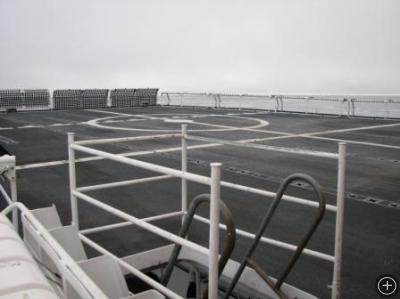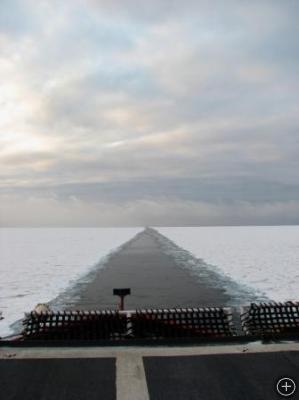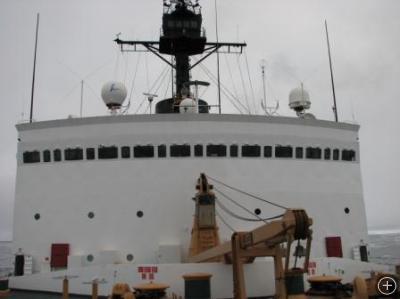Searching for Ice in the Arctic
ABOARD THE USCGC POLAR SEA, ON THE ARCTIC OCEAN– Last night I had the opportunity to give a general presentation on this research project in the mess deck. Around 50 people attended, including many of the crew members of the ship, and it was a great chance to describe the general goals of the project and to present pictures and videos of previous captures. A general discussion followed the presentation, and hopefully a lot of folks running the ship took away a deeper understanding of the scientific goals we are pursuing.
This morning at breakfast we received word that we were within 20 miles of the last known location of a bear we are targeting for capture. Over the previous 24 hours we had cruised through several hundred miles of open water, and we hoped to be approaching the edge of the retreated sea ice; however, with only 20 miles between us and the bear, it was only open water in sight. We cannot dart a bear on small pieces of ice with much open water in the area – there is a possibility that a bear may run into the water to swim away, which is dangerous if the animal is going under the anesthetic. However, by the end of breakfast ice had been spotted, and we were still hopeful.
By 9am I went up to the bridge to see what the conditions looked like and await the daily flight briefing. This far north and west, sunrise is late – official sunrise today at our location was 947am. Thus the bridge was still dark and all the lights were dim red. This provides enough light for crew members to perform their jobs but it doesn’t force their eyes to adjust to bright light, which reduces their vision in the dark. Two huge floodlights lit the path in front of the icebreaker. Loose pieces of newly-formed ice, most no larger than several feet across, gently rolled over waves, but there was no thick ice in sight. As we moved west by southwest the ice seemed to get a little thicker so the flight briefing went on as planned and by just about dawn, the first helicopter launched.

The helicopter deck of the ship. To the right is the hangar. After landing, temporary wheels are attached to the skids of each helicopter and they are rolled from this deck into the hangar.
The first helicopter, carrying scientists from USGS and USFWS, radio-tracked our target bear and made visual contact. Unfortunately, the bear was standing on a piece of thick ice around 15 meters across, which was much too small for a safe darting operation. The helicopter gained altitude and scouted the surrounding area but did not see any promising ice. They returned to the ship and we had to make the decision to forego this bear and start cruising towards the next animal. Temperatures have been hovering in the low 30s (Fahrenheit), which is simply too warm for much formation of new ice. We need our bears to move onto thicker ice, or for the temperatures to drop so the new ice increases in thickness. The next target bear is over 100 miles to the north and seems to be quite a distance in from the ice edge, hopefully on thick ice remaining from last winter.

As we began cruising north from the location with poor ice, the ice immediately became thicker. Looking aft from the helicopter deck, we are leaving a trail of open water through about 3-6 inches of sea ice. By now I could walk across the ice and in an emergency, a helicopter could probably land on it. However, conditions still are not good enough for a capture operation.
As we began cruising north I took my lunch to a port-side lower deck and watched the ice go by; almost immediately, it began getting thicker. By evening we will be in position to launch for the next bear, but we will not have enough daylight. Thus we plan to launch at dawn tomorrow, and we hope to find thick ice from last winter to work on.











Wow.Sounds like you are staying busy and how neat to know how close the bear is so you can still do your work and research.I love the photoes by the way too.